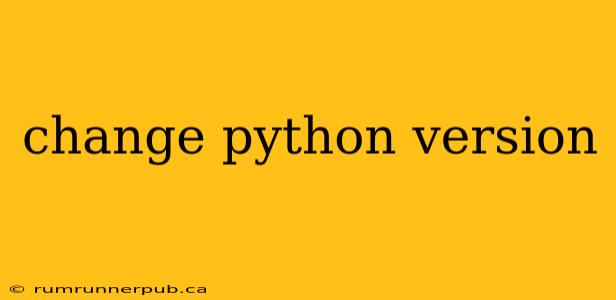Python's versatility stems partly from its multiple versions, each with improvements and new features. However, managing these versions can be tricky. This article tackles the common challenges of switching between Python versions, drawing upon insights from Stack Overflow and offering practical solutions.
Why Change Python Versions?
Often, you'll need to switch Python versions due to:
- Project Requirements: Different projects might demand specific Python versions due to library compatibility. An older project might rely on features unavailable in newer versions, or a cutting-edge project might necessitate the latest Python features and performance enhancements.
- Library Compatibility: A library you want to use might only be compatible with a particular Python version. Checking the library's documentation is crucial here.
- Bug Fixes and Security Patches: Newer versions often include critical bug fixes and security updates, making it essential to upgrade regularly for a stable and secure environment.
Methods for Managing Python Versions
Several strategies exist for managing multiple Python versions, each with its pros and cons:
1. Using a Version Manager (Recommended):
This is the cleanest and most recommended approach, particularly if you're working with multiple projects needing different Python versions. Popular options include:
-
pyenv: (as discussed in various Stack Overflow threads, e.g., this one focusing on Ubuntu) pyenv allows you to easily install, manage, and switch between different Python versions without affecting your system's default Python installation. It's platform-agnostic and works well on macOS, Linux, and even Windows with the help of tools like pyenv-win.
-
conda: Conda, primarily associated with the Anaconda distribution, is a powerful package and environment manager. It's excellent for managing project dependencies and creating isolated environments, each with its own Python version and packages. Many Stack Overflow questions, like this one detail conda's usage for version switching. Conda's strength lies in its package management capabilities, simplifying the installation and updating of libraries.
Example (pyenv):
- Install pyenv following instructions on the pyenv GitHub page.
- Install a specific Python version:
pyenv install 3.9.13 - Set the global Python version:
pyenv global 3.9.13(or usepyenv local 3.9.13to set it for a specific directory) - Verify the installation:
python --version
2. Direct Installation (Less Recommended):
Installing multiple Python versions directly onto your system is generally discouraged. It can lead to conflicts and confusion. However, on some systems with careful management (and understanding of your system's package manager), it might be possible. This approach requires significant system administration knowledge and is prone to errors. Many Stack Overflow discussions discourage this method due to the potential for breaking your system.
3. Virtual Environments (Essential, regardless of the method above):
Even if you're using a version manager, creating virtual environments using venv (for Python 3.3+) or virtualenv is crucial for isolating project dependencies. This prevents conflicts between different projects' libraries. Stack Overflow frequently emphasizes the importance of virtual environments for clean project management.
Example (venv):
- Create a virtual environment:
python3 -m venv myenv - Activate the environment:
source myenv/bin/activate(Linux/macOS) ormyenv\Scripts\activate(Windows) - Install project-specific packages:
pip install -r requirements.txt
Choosing the Right Approach
- For simple projects and limited version needs, direct installation (with extreme caution) might suffice, coupled with virtual environments.
- For managing multiple projects with differing Python versions, pyenv or conda are strongly recommended for their ease of use and efficiency.
- Virtual environments are always recommended, irrespective of your Python version management strategy.
This comprehensive guide, leveraging insights from Stack Overflow's wealth of information, empowers you to navigate the world of Python version management efficiently and safely. Remember to consult the official documentation for pyenv, conda, and venv for the most up-to-date instructions and best practices.
